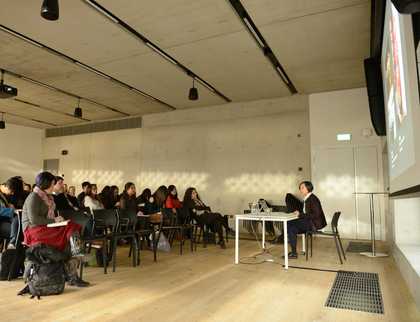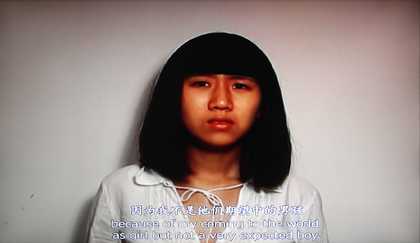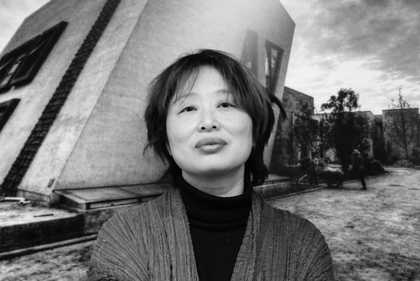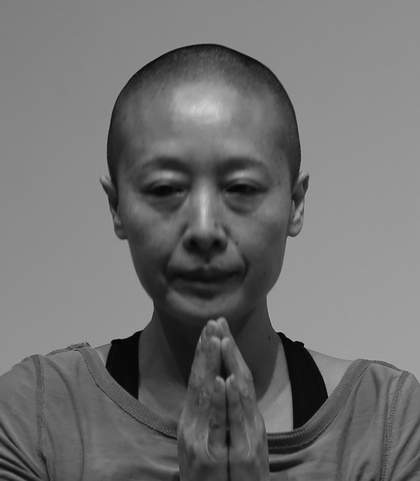
He Chengyao
Image courtesy of the artist
Monica Merlin: I’d like to talk about your 2001 work Opening the Great Wall. What did you think about the way people reacted to the piece at the time?
He Chengyao: It was not good, actually. That was my first time working with performance art, so I did not know how to do it. After the work was finished, there were many voices of opposition. Most of them criticised the exposure of the female body, because in traditional culture there is discrimination against women and oppression of women – for example, the idea is that women should not be nude, even partially, in public.
I was very sad at the time, because most of the opposition came from the art world. I never thought that this act would cause such uproar. I really did not expect it, so I was very unhappy. But because I was very surprised, I started to think about these issues. After this happened, I thought that perhaps these problems had always existed, but I had not acknowledged their existence because I had never come into contact with them.
Since that time, I have given some thought as to why I did the piece in that way and looked for the reasons within the work itself. In one way, I am grateful that there were critical and opposing voices, because at the time I was not sure why I did it. Later, when I reflected upon it, I realised that while I thought the work was only related to a personal issue – my complicated family history – it had wider social ramifications. Why was it opposed on a social level? Because it exposed a social problem. My family issues also brought up historical and social issues. My family lived through the Cultural Revolution. My father and mother did not work, though each had their own reason, for example, my mother suffered from mental illness.
I have analysed it step by step, from myself, to my family and finally to the wider social environment in China. This analysis relates to my later works too, including Mother and Me, the acupuncture piece and the work about people with mental illness and children from poor families. This is the thread that runs through these works.
Monica Merlin: Yes, many of your works are related to your family history and your own memories. Can you talk a little more about that?
He Chengyao: Monica, I hope that you understand, these are works from 2001 and you can read about them in books. Lots of people have written about them and interviewed me about them. I am not willing to talk about this anymore. Even though those works are already in the past, I am really not keen to talk about them.
Monica Merlin: No problem. If there is nothing more to say about those previous works, then that is fine.
He Chengyao: Actually, I still have strong emotional connections to those works. But for me, they belong to the past, including the acupuncture piece and so on. They were produced at a time when I was experiencing a lot of pain. At that time I felt like there were ‘ten thousand arrows piercing through the heart’, as the traditional Chinese saying goes. The tremendous pain and sorrow whenever I thought about my mother lasted for many years and my heart became heavier and heavier under this pain. Later, my heart felt much lighter after I made works with my mother’s photos. Sometimes when I talk about this, it is like re-opening an already healed wound, so I do not want to talk about it anymore.
Monica Merlin: It is absolutely fine. Could you talk a bit more about the documentary Families Afflicted by Mental Illness?
He Chengyao: I did Families Afflicted by Mental Illness in 2007. At that time, the piece was also linked to my own family history and stories of my childhood. After I completed it, I felt like the work was a sort of mental therapy. A therapist makes the patient pour his or her heart out through talking. But the method I used was art. I used my own method to get it out and in doing so I have become a new person. I can be strong and have the ability to care for other people and perhaps help them. I hope people can pay attention to the children from poor families and those who suffer from mental illness. I myself came from that kind of family.
Sometimes relatives can say very cruel things to each other. During an interview I did with a woman whose daughter had mental illness, the woman told me her son asked her to get rid of her daughter. He advised her to rent a car, take the daughter to the middle of nowhere, drop her off and get rid of her. At the time of my mother’s illness, my own grandmother said she could not take it anymore. She said she wanted to buy rat poison and fatally poison my mother. They would say those kinds of things. There was another family like this: Yu Shuqin had two older sisters and one older brother who were all mentally ill. She said they were worse than pigs and dogs and would swear at them. But I know that in reality the relatives love each other despite mental illness.
I wanted to interview them and present their most honest side to the audience. I wanted to show the lives of people who suffer from mental illness and their families, and to present the material and psychological world they occupy. I went to my hometown to do this. It is where I was born, so people know and understand my family and would tell me anything without reserve. This kind of relationship is more honest, which I think is better. They did not oppose me doing this because they wanted more people to understand their situation. After seeing my interviews, the local government gave the families a stipend.
Monica Merlin: That is impressive. I know you are working on a new project. Can you talk about it or is it too soon?
He Chengyao: I have been preparing these works for a long time. I went to the Tibetan area and stayed in a monastery for over a year, which changed my life and worldview. The way I look at the world now is through Buddhist teachings and from a Buddhist perspective, including how I understand human existence. Before then, I was always searching for the meaning of life, the reason why we are alive and what we should do with ourselves.
There is a work called Illusions that I did in 2002. It was recorded in twelve photos. During the performance I got a male member of the audience to hold up a mirror to reflect the sunlight onto the wall where I was catching the light. At that moment, I suddenly realised that life did not have any particular meaning – everyone simply carries on with his or her life. In this work, the light came to represent life, as well as the things we desire, be it power, money, or romantic love. When you try to catch this beam of light, you realise that you cannot possess it, so what meaning does it have? How can we understand it while we are alive? How can we bring out those higher qualities that we have within? How can we be compassionate? How can we help others? How can we cultivate our love for others? After we have cast ourselves off and solved our own basic needs, what can we do for the society and the world? How can we fulfil our life’s mission?
So I went to volunteer as a teacher in the Tibetan area as a person, not as an artist. I did not go there to make art. Some people think that volunteering is a patronising act. I am the giver and they are the receiver. I do not think it should be like that. I think if you are doing charity work, you must see those around you as equals. You must first look at what people need and then give that to them. If a person has been hungry for two days, it would be ridiculous to be kind by giving him books, saying that books are great and that he or she should read them. What you should give him or her instead is something to eat. I think that when you are trying to help others, you should think first about what they actually need.
I actually did not go to volunteer with any organisation, I just found a lama online and I sent him a message asking if they needed a teacher. I was a primary school teacher for three years and a secondary school teacher for another three years, so I had the necessary experience. I decided to go as an ordinary person, because sometimes I think that people have a certain expectation of artists. They think there is something lofty about them. A lot of artists themselves think, ‘I am doing cultural work so I am superior.’ I do not think it should be like that. In fact, artists do not have any legitimate reason to behave in such a spoiled manner – ‘I’m an artist so I should have this or that.’ Lots of people work so hard in China. So why should artists get special treatment? It is for this reason that I went to Tibet as an ordinary person, not as an artist.
During my time in Tibet, I learnt a lot from the lama and the lama’s students in the monastery. Our life was very simple, but we were very happy. I laughed every day. When I came back and started my new artworks, I felt like working became a kind of meditation, a kind of self-cultivation. During the process, I would take every second and cast it into the image. It is a kind of non-action that comprises both purposeful and aimless gestures – but a non-action that ultimately takes the shape of a canvas. I think that life is like this. Everyone does something here and then a new job or position elsewhere, in such a way that our lives appear disordered. But in reality, when life comes to an end, you realise it has turned into a beautiful pattern and that the life did have a meaning. I think so, anyway.
Monica Merlin: Does this piece have a title?
He Chengyao: I haven’t really given it a title yet. Maybe I will call it One Second, because everything in the work is measured in time. I indicated how long each one took.
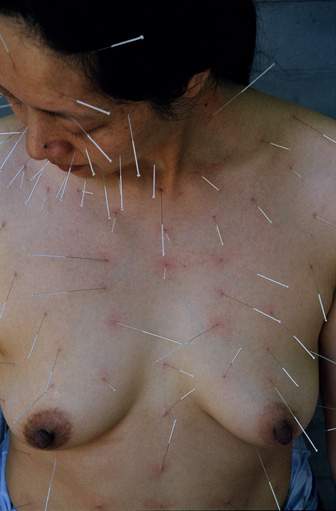
He Chengyao
99 Needles 2002
Chromogenic photograph
Image courtesy of the artist
Monica Merlin: Looking at contemporary art in China today, what do you think is the status of women artists?
He Chengyao: This question is quite big. I think that women are in a weak position across Chinese society. That is why there are many women willing to become mistresses or have someone maintain them financially. It seems that their ideal is to find a rich boyfriend or husband so that they will have everything without facing challenges in the world themselves. This phenomenon reveals a problem, which is that women are still in a lower position. In order to obtain a sense of security, they choose to become a dependant of someone else rather than pursuing independence. This is the overall picture.
If we look at women artists in China, the situation is more or less the same. Compared to developed countries or democratic countries, China has fewer women artists. I started doing performance art in 2001 and I have always stayed in China. I am a Chinese citizen, I live in China and I am the woman who has been doing performance art for the longest in the country. Others have left the country or have obtained foreign citizenship. This means that in China there are few women doing performance art or other art like installation, video or photography. It seems that women take on a very traditional role after they get married or have children. They take on the role that society expects of them, which is that of a dutiful wife and mother.
There are few women who manage to continue their career as artists. If they do, they have to sacrifice a lot. Many women artists are single. Those of us who do performance art have trouble earning enough money. China does not have a well-developed system for artists. Normally when I do performance art abroad, they pay for my plane ticket, accommodation and meals with funding from their country’s art organisations. This does not happen in China. Performance art is quite disparaged here.
You saw this just now, with the example of my work. If women use their bodies to make art, people will criticise them. Whether people understand art or not, they would criticise you. But if you use other methods – installation, video, painting or sculpture – then of course you can use female nudes. Why is the body not allowed in performance art? I think that when we use nudity in performance art, it is because the artwork requires it, not because we want to be naked. We are not exhibitionists!
Monica Merlin: Have you experienced any particular issues in China when exhibiting your art or doing performances?
He Chengyao: After I did the piece Public Broadcast Exercises in 2004 at Shanghai Duolun Museum of Modern Art, everyone was very critical. When the exhibition moved from Shanghai to Beijing, I did a piece in which I wrote down my bad experience in Shanghai in three notebooks, let the audience read it and invited them to write down their answers to the following questions: What qualities do you think an outstanding woman should have? Do you think women have the right to be naked? There was another question but I forget.
I think it was a very interesting experience. Because the piece was exhibited at 798, there were some working class people who came to see it. Not all of them wrote their responses but our conversations were very interesting. They said, ‘Hey, how come I have never thought about these questions before?’ Just as I had not considered these questions until that exhibition, neither had they.
After I experienced this, I learned to be very cautious when my artwork required me to use nudity in China. But I did not use nudity in my art again in China. I did in Busan in Korea and it was the first time that a woman had done a nude work there. But they accepted it.
Asian countries such as Japan, Korea and China are all countries deeply influenced by the Confucian tradition. It is inevitable that the people living in these countries have deep-rooted norms concerning women. In people’s minds, behaviour that does not comply with traditional culture is bad. Every time I go abroad and see Western women using their bodies to make art, they are very confident and calm even if they are nude. They are not ashamed and they do not hesitate. I think that the Confucian, traditional culture discriminates against the body and the flesh. It sees it as filthy and sexualises it.
In reality, I think that the body is similar to money – it is neutral, neither good nor evil. I tend to think that it is more on the good side. It is good no matter what it is like or who it belongs to. No matter if it is the body of a beggar on the street, or a body that has lots of wrinkles and freckles, or a body that is diseased or disabled, all bodies are good and beautiful, because they have a history and they are alive. Each body contains an experience within it; each body has a story.
Monica Merlin interviewed He Chengyao in her studio in Beijing on 20 November 2013.

